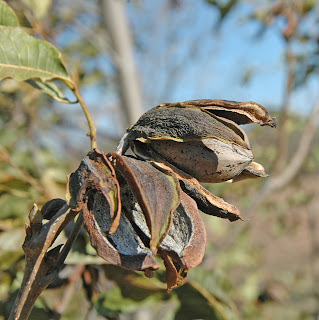 |
| Kanza leaves and shucks killed by freeze |
It has been over a week since a strong arctic air mass descended across the central plains and ended the 2022 growing season. I recorded 19 degrees F (-7 C) at dawn and knew immediately that pecan leaves and shucks would be killed. Pecan leaves were freeze dried on the tree and hung on for about a week before dropping to the ground. The freeze had little impact on the pecans that had already split their shucks. However, as I mentioned in earlier posts, the extended drought we have suffered this year inhibited normal nut ripening.
Fortunately, most of my Kanza nuts had split their shucks before the freeze and have opened up normally (photo at right). Young Kanza trees (< 6" DBH) suffered more from the drought and have produced much smaller nuts that did not open (100% stick-tights).
 |
| Thayer nuts after freeze |
 |
| Hark nuts after freeze |
Caney was one cultivar that split open before the freeze and will fall free from the shuck at harvest (photo at left). But since this was one of the very few trees that opened up early, Caney became a prime target for crows to devour. The nut cluster pictured at left had three nuts but only one remains. A hungry crow knocked two nuts out of their shucks and onto the ground. Flying down to the dropped nuts, the crow then used its beak to crack open the nuts and consume all the kernels.
An early Fall freeze can damage the cambium of current season grafts. So while I was out inspecting my nut crop, I stopped at a vigorously growing scion to check for damage. The tree pictured at right was grafted this past Spring using a bark graft. The scion had grown over five feet in height (fantastic for a drought year). Unfortunately, this tree was not prepared for such a quick drop in temperatures. The freeze killed all the foliage but the most serious cold damage can only be revealed by inspecting the cambium on the scion shoot. Using my knife, I peeled back the bark to expose the inner bark and cambium. The inner bark of healthy twigs should be green in color. This tree had significant internal browning which indicates cold injury.
I'll need to watch this tree carefully next Spring for signs of bud break. This tree will most likely suffer die-back or I could loose the entire scion. From past experience, I've noticed that a freeze damaged grafts usually re-sprout from below the graft union. If that happens, I'll need to train a trunk sprout to a central leader then re-graft the tree in the Spring of 2024.


